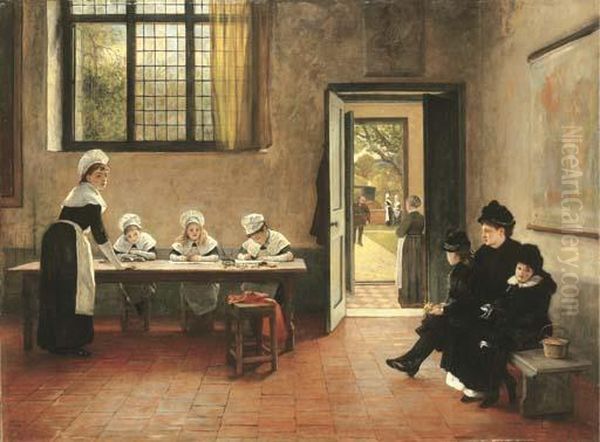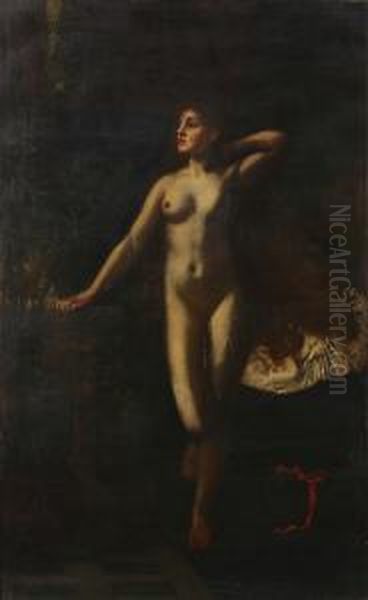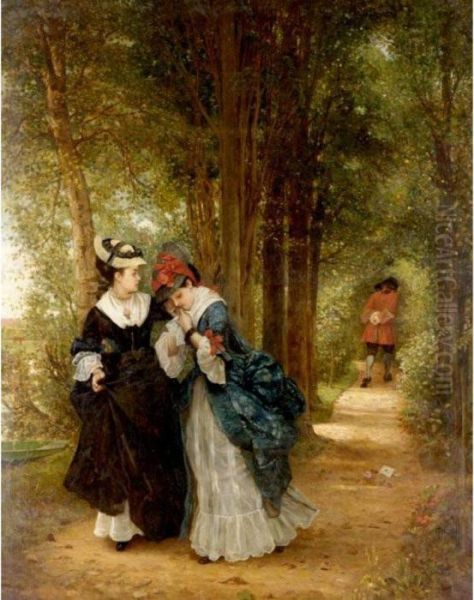George Adolphus Storey (1834–1919) stands as a significant, if sometimes overlooked, figure in the rich tapestry of 19th-century British art. A painter of genre scenes, portraits, and historical subjects, as well as an influential teacher and author, Storey navigated the evolving artistic landscape of Victorian England with a distinct charm and technical proficiency. His career spanned a period of immense change, from the lingering romanticism of the early century through the ascendancy of Pre-Raphaelitism and the establishment of a robust academic tradition, to the stirrings of modernism. Storey's contributions, particularly his engaging narrative paintings and his scholarly work on perspective, offer valuable insights into the artistic and cultural milieu of his time.
Early Life and Artistic Formation
Born in London on January 7, 1834, George Adolphus Storey's early life provided a cosmopolitan foundation for his future artistic endeavors. His education was not confined to England; he spent time in Paris, an experience that undoubtedly broadened his artistic horizons and exposed him to different pedagogical approaches and aesthetic sensibilities than those prevalent in London at the time. This early immersion in French culture would have provided him with a firsthand look at the French academic system and the burgeoning realist movements.
Upon returning to London, Storey continued his artistic training. He studied at Leigh's Academy, a well-regarded art school run by James Mathews Leigh, which served as a preparatory institution for many aspiring artists aiming for the Royal Academy Schools. It was during this period that he also reportedly received encouragement and perhaps informal guidance from the sculptor William Behnes, a prominent figure known for his portrait busts and public monuments. Such interactions would have provided Storey with diverse artistic perspectives.
The pivotal step in his formal art education came in 1854 when he was admitted to the prestigious Royal Academy Schools. This institution was the cornerstone of artistic training in Britain, and entry was highly competitive. Here, students underwent rigorous instruction in drawing from the antique and the live model, anatomy, and perspective, all designed to equip them for a career as professional artists, typically aspiring to exhibit at the Royal Academy's annual exhibitions.
Artistic Development and Stylistic Evolution

Storey began exhibiting his work at the Royal Academy as early as 1852, even before formally entering its schools. His early works showed an affinity with the Pre-Raphaelite Brotherhood, a group that had caused a sensation in the British art world with its emphasis on meticulous detail, vibrant colour, truth to nature, and often morally or literarily inspired subject matter. Artists like John Everett Millais, William Holman Hunt, and Dante Gabriel Rossetti had championed this revolutionary approach. While Storey was not a member of the Brotherhood, the influence of their aesthetic – particularly their detailed rendering and narrative clarity – can be discerned in his initial output.
However, Storey's style did not remain static. As his career progressed, he moved away from the intense medievalism and overt symbolism of the Pre-Raphaelites, developing a more personal and arguably more accessible style. He became particularly known for his genre paintings, which depicted scenes of everyday middle-class life, often with a gentle narrative or romantic undertone. These works were characterized by their elegance, refined execution, and a keen observation of social manners and human relationships. His paintings frequently told stories, inviting viewers to engage with the characters and their implied situations. This narrative quality was highly popular with Victorian audiences, who appreciated art that was both aesthetically pleasing and emotionally engaging.
His portraiture also gained recognition. He possessed the ability to capture not only a likeness but also the character of his sitters, often imbuing them with a quiet dignity. His skill extended to historical subjects, though these were perhaps less central to his oeuvre than his contemporary genre scenes. Throughout his stylistic evolution, a commitment to sound draughtsmanship and a harmonious use of colour remained constants.
The Royal Academy and Public Recognition
The Royal Academy of Arts was central to Storey's career. He was a consistent exhibitor from 1852 until the year of his death. His dedication and the quality of his work led to his election as an Associate of the Royal Academy (ARA) in 1876, a significant mark of recognition from his peers. He was later elected a full Royal Academician (RA) in 1914, a late but deserved honour.
Beyond exhibiting, Storey took on an important teaching role at the Royal Academy. From 1900 until his death in 1919, he served as the Professor of Perspective. This was a prestigious and demanding position, requiring a deep theoretical understanding and the ability to communicate complex principles to students. His long tenure in this role underscores his mastery of this fundamental aspect of academic art. The ability to create convincing illusions of space and depth was paramount for the narrative and historical paintings favored by the Academy, and Storey was a key figure in imparting this knowledge to new generations of artists.
The St John's Wood Clique

Storey was a prominent member of the St John's Wood Clique, a group of artists who shared social and professional bonds and were largely based in the St John's Wood area of London. This informal collective, active primarily in the 1860s and 1870s, included figures such as Philip Hermogenes Calderon, William Frederick Yeames (famous for "And When Did You Last See Your Father?"), Henry Stacy Marks, David Wilkie Wynfield (also a noted photographer), John Evan Hodgson, and George Dunlop Leslie.
The Clique was characterized by a shared interest in historical and literary genre subjects, often with a humorous or anecdotal flavour. They were known for their camaraderie, frequently socializing, sharing studios, and even collaborating on projects or offering mutual criticism. Their approach to art was generally less radical than that of the Pre-Raphaelites, aligning more closely with the mainstream tastes of the Victorian art-buying public, though they maintained high standards of technical execution. The group often drew inspiration from history, literature, and everyday life, creating accessible and engaging narratives. They sometimes rented Hever Castle in Kent as a shared retreat and a source of picturesque backdrops for their historical paintings, fostering a spirit of collaborative creativity. Storey's involvement with this group places him firmly within a significant social and artistic network of the period.
Notable Works
Throughout his long career, George Adolphus Storey produced a considerable body of work. While a comprehensive list is extensive, several paintings stand out as representative of his style and thematic concerns:
One of his early works, "The Young Fishermen" (exhibited 1850), already hinted at his sensitivity to light and atmosphere, and his interest in everyday human activity.
Works exhibited at the Royal Academy in his early years, such as "Family Group" (1852), "Madonna" (1853), and "Holy Family" (1853), likely reflected his initial Pre-Raphaelite leanings or his exploration of traditional religious themes with a contemporary sensibility.
"The Duet" (exhibited RA 1869) is a fine example of his mature genre style. It depicts a young man and woman at a piano, a common Victorian theme symbolizing courtship and domestic harmony. The painting is notable for its delicate rendering of figures, fabrics, and the interior setting, as well as its subtle emotional narrative.
"Scandal" (exhibited RA 1873) showcases Storey's ability to capture social dynamics and gentle satire. Such works often invited viewers to ponder the unspoken interactions and societal norms of the time.
"My Mother" (1874) is a tender and accomplished portrait, demonstrating his skill in capturing likeness and personality. This work, held by Tate Britain, reveals a more intimate side of his artistry.

"The Connoisseur" (exhibited RA 1883) depicts an elderly gentleman examining a piece of porcelain, a theme that reflects the Victorian passion for collecting and appreciating art and antiques. It’s a quiet, contemplative scene, rendered with Storey's characteristic refinement.
Other notable paintings include "A Shy Pupil," "Orphans" (exhibited RA 1879), and "Godiva" (exhibited RA 1899). These titles suggest the range of his subject matter, from intimate domestic scenes and moments of quiet pathos to more dramatic historical or legendary themes. His illustrations also contributed to his reputation, appearing in popular periodicals and books, thereby reaching a wider audience.
Literary and Academic Pursuits: "The Theory and Practice of Perspective"
Beyond his achievements as a painter, George Adolphus Storey made a lasting contribution to art education through his writings, most significantly his book "The Theory and Practice of Perspective" (1910). Published during his tenure as Professor of Perspective at the Royal Academy, this volume distilled his extensive knowledge and teaching experience into a comprehensive guide.
The book was meticulously structured, covering the fundamental principles of linear perspective, including the concepts of the horizon line, vanishing points, and the projection of objects in space. It also addressed aerial perspective – the means by which artists create a sense of depth through gradations of tone and colour. Storey's text was practical, providing clear explanations and diagrams intended to help students and practicing artists master the complexities of representing three-dimensional space on a two-dimensional surface.
The importance of such a treatise in the early 20th century cannot be overstated. While photography was well-established, the ability to construct convincing perspective was still a cornerstone of academic painting, particularly for artists creating large-scale historical, mythological, or complex genre scenes. Storey's book would have been an invaluable resource, not only for painters but also for illustrators, architects, and designers. It codified principles that had been developed since the Renaissance by artists like Leonardo da Vinci and Albrecht Dürer, and refined by later theorists and practitioners. His work built upon a long tradition of perspective manuals, offering a clear and contemporary approach for students of his time.
Storey was also known to be a man of broad cultural interests, reportedly writing poetry, plays, essays, and keeping detailed diaries and sketchbooks. This literary inclination suggests an intellectual depth that complemented his visual artistry, making him a well-rounded figure in the Victorian cultural landscape.
Wider Artistic Context and Contemporaries
To fully appreciate Storey's position, it's helpful to consider him within the broader context of Victorian art. He worked during a period dominated by towering figures of the Royal Academy, such as Lord Frederic Leighton, Sir Edward Poynter, and Sir Lawrence Alma-Tadema, who specialized in grand classical and historical subjects. While Storey also tackled historical themes, his primary strength lay in more intimate genre scenes.
In the realm of genre painting, he can be compared to contemporaries like William Powell Frith, whose panoramic depictions of modern life (e.g., "Derby Day," "The Railway Station") were immensely popular, or Luke Fildes, known for his socially conscious works like "Applicants for Admission to a Casual Ward." Storey's genre paintings, while sharing a focus on contemporary life, often possessed a quieter, more domestic charm than the sprawling canvases of Frith or the overt social commentary of Fildes.
His connection to the St John's Wood Clique placed him in a circle that, while respecting academic traditions, often favored subjects that were more relatable and less grandiose than the high art of Leighton or Poynter. This group carved out a niche for narrative paintings that appealed to the sentiments and experiences of the burgeoning middle class.
The art world Storey inhabited was vibrant and multifaceted. The annual Royal Academy Summer Exhibition was a major social and cultural event. Illustrated magazines and books created a huge demand for artists who could work as illustrators, a field in which Storey also participated. The rise of art dealers and commercial galleries provided alternative venues for exhibiting and selling art, though the Royal Academy remained the most prestigious.
Later Life and Legacy
George Adolphus Storey remained active as an artist and teacher well into the 20th century. His election as a full Royal Academician in 1914, at the age of 80, was a testament to his enduring presence and respected status within the British art establishment. He continued to teach perspective at the Royal Academy Schools until his death.
He passed away on July 29, 1919, in London, and was buried in Hampstead Cemetery. His life had spanned a remarkable period of British history and art, witnessing the peak of Victorianism and the dawn of a new, more turbulent century.
Storey's legacy is multifaceted. As a painter, he contributed a significant body of work characterized by its charm, technical skill, and gentle narrative appeal. His genre scenes provide valuable visual records of Victorian middle-class life, its customs, and its sentiments. While perhaps not as revolutionary as the Pre-Raphaelites or as grand in ambition as some of his academic contemporaries, his work possesses an enduring appeal and historical importance.
His role as a member of the St John's Wood Clique highlights the importance of artistic communities and networks in fostering creativity and shaping artistic trends. The Clique represented a significant strand of Victorian art that balanced academic tradition with popular appeal.
Perhaps his most enduring scholarly legacy is "The Theory and Practice of Perspective." This book served as a key educational text and remains a valuable historical document on the teaching of this fundamental artistic skill. In an era before the widespread abstraction that would characterize much of 20th-century art, mastery of perspective was essential, and Storey was one of its foremost British exponents and teachers.
Conclusion
George Adolphus Storey RA was a distinguished artist and educator whose career reflects the tastes and preoccupations of Victorian and Edwardian England. He successfully navigated the demands of the art market and the academic establishment, producing a body of work that was both popular in its time and continues to hold interest for its artistic merit and historical insight. His paintings offer a window into the domestic and social life of his era, rendered with a characteristic elegance and narrative skill. Furthermore, his contribution to the study and teaching of perspective cemented his reputation as a learned and influential figure in the British art world. While the grand narratives of art history sometimes overshadow quieter, more nuanced careers, George Adolphus Storey's dedication to his craft, his charming depictions of life, and his scholarly contributions ensure his place as a respected figure in the annals of British art. His work reminds us of the rich diversity of Victorian artistic production and the enduring appeal of well-crafted, thoughtfully conceived paintings.